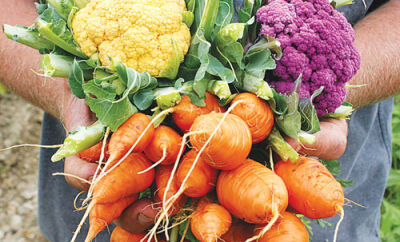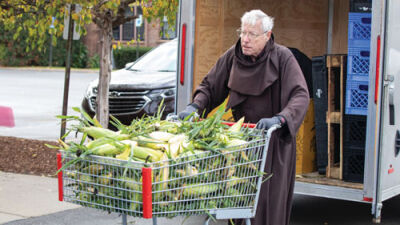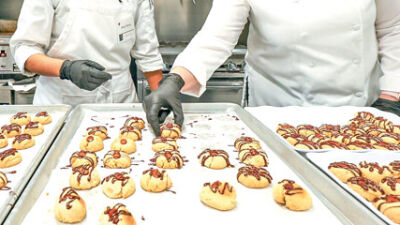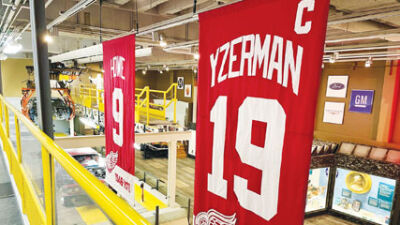
Read the labels of each plant and know how much sun exposure and water it needs to thrive.
Photo provided by Michigan State University Extension
METRO DETROIT — Two master gardeners from Michigan State University Extension recently shared their expertise on composting and gardening during presentations at the Bloomfield Township Public Library.
Imagine food rotting away in a garbage can and then being transported to a landfill, or intentionally disposing of food scraps to enrich the soil.
Which sounds better?
Composting describes the intentional way of disposing of organic waste to enrich the soil.
Michigan State University master gardener Sara Covatta presented “Helping to Demystify and Normalize Composting in Michigan” at the Bloomfield Township Public Library April 22. She defined compost as a dark, crumbly material with an earthy smell that is produced by the natural decomposition of organic materials. Compost is a living soil amendment. Microbes do all the work to break down the materials.
Some composting enthusiasts have suggested having a container to collect food scraps in the kitchen and store it in the freezer. After a week or month of collecting, see how much has been collected. From that, determine what size compost bin is needed.
To start composting, Covatta recommended collecting vegetable scraps, coffee grounds and egg shells.
Use a carbon source, such as fall leaves, in the compost bin. Stockpile the leaves that fall from the trees in the autumn. Store the leaves in an enclosed container by the compost bin. Covatta suggests that whenever adding to the compost bin, add the leaves. This prevents odors and breaks down the food properly.
If the center of the composting pile is dry, add water and turn the pile.
If the pile is damp and will not heat up, this is due to a lack of nitrogen, according to Covatta. Mix in a nitrogen source such as grass clippings.
“Despite my efforts, there are people who are not going to backyard compost,” Covatta said in a subsequent interview.
According to Covatta, people are unnecessarily afraid of composting.
“Municipalities, businesses, schools are sometimes afraid to add food scrap collection, but their fear is really misplaced,” Covatta said. “Because if the thought process is you’re going to attract rodents by having a food scrap collection when you’re already putting it in the garbage, that’s really not a very rational thought process.”
Composting food scraps produces dividends.
“We really truly have to start looking at food scraps as a resource and an extremely valuable resource that is not waste,” Covatta said. “It allows us to make a really valuable product.”
According to Covatta and other master gardeners, soil with compost improves plant growth, reduces soil erosion, benefits soil structure, and allows soil to retain more water and nutrients.
Every 1% increase in organic matter can result in up to 20,000 gallons more water held in the soil per acre, according to the presentation. The presentation said that healthy soils have high water-holding capacity.
“Composting is awesome,” Michigan State University Extension advanced master gardener Louise Sloan said. “I am making free fertilizer to enrich my yard.”
In her presentation, “Working with Your Garden, Not Against It,” April 29, she focused on soil, light and labels.
Sloan referred to the soil as the foundation of the garden.
“If we don’t take care of our soil, our plants aren’t going to do well,” Sloan said.
She categorizes Michigan as having “great soil,” and the soil in its yards are a “precious, precious commodity.”
According to Sloan, only 10% of the earth has growable or arable soil.
She recommends getting a soil test of the area in which one plans to plant. A sample can be mailed to the Michigan State University Extension. Visit shop.msu.edu/products/soil-test-mailer for more information.
The results of the soil test will include the pH of the soil, which indicates the acidity or alkalinity of the soil. A pH of 7 represents neutrality of the soil. Numbers below that represent increasing acidity levels, while numbers above 7 indicate increasing alkalinity. According to the Michigan State University Extension soil testing website, a pH of 6 to 7 is optimal for nutrient availability for plant growth.
“There are 18 nutrients that are really important that help plants live,” Sloan said. “If you already have it (those nutrients), you don’t have to add it, but if it (soil) is deficient, you will want to add it.”
According to Sloan, compost can be added to the top of the soil. Let water and Mother Nature work it in the soil without tilling.
Light is integral to any garden, and every plant has a different need for light.
Sloan suggests looking at the various locations across one’s yard throughout the day and in different seasons. A south-facing yard gets the best sun, according to Sloan. The north side of the home is generally going to be cooler and not have as much light.
The east side will have the morning sun, which is generally cooler than the west side, which has sun exposure from midday to sunset.
Don’t be fooled by the sunlight in the winter, when no leaves are on the trees, and put in tomato plants or other plants that need full sunlight where there will be shade once the trees have full foliage. According to Sloan, it will be a disaster.
When buying plants, look at the plant label that comes with it, which indicates how much light and water the plant needs to thrive, and follow the label, Sloan suggested.
Whether composting or gardening, finding good information is key. For more information visit canr.msu.edu/home_gardening and canr.msu.edu/home_gardening/tip_sheets.
 Publication select ▼
Publication select ▼
























